Art Therapy in Australia: Exploring Practices, Research, and Settings
VerifiedAdded on 2020/04/13
|14
|3755
|275
Report
AI Summary
This report provides a comprehensive analysis of art therapy in Australia. It begins by defining art therapy and its origins, emphasizing its therapeutic use for mental and physical illnesses. The report identifies key organizations, such as ANZATA, and leading institutions like The IKON Institute and Phoenix Institute, highlighting their contributions to the field. It discusses various types of art therapy used, including collage, phototherapy, family sculpture, digital art, and painting, and details their application in treating patients. The report also explores the different settings where art therapy is practiced in Australia, including schools, health facilities, and universities. Finally, it examines the research conducted on art therapy in Australia and its impact on the profession. The report offers insights into the growing popularity of art therapy and its potential to promote social, emotional, and psychological well-being in the Australian community.

Name of student:
Registration number:
Unit Title:
Unit Code:
Name of supervisor:
Date due:
Registration number:
Unit Title:
Unit Code:
Name of supervisor:
Date due:
Paraphrase This Document
Need a fresh take? Get an instant paraphrase of this document with our AI Paraphraser
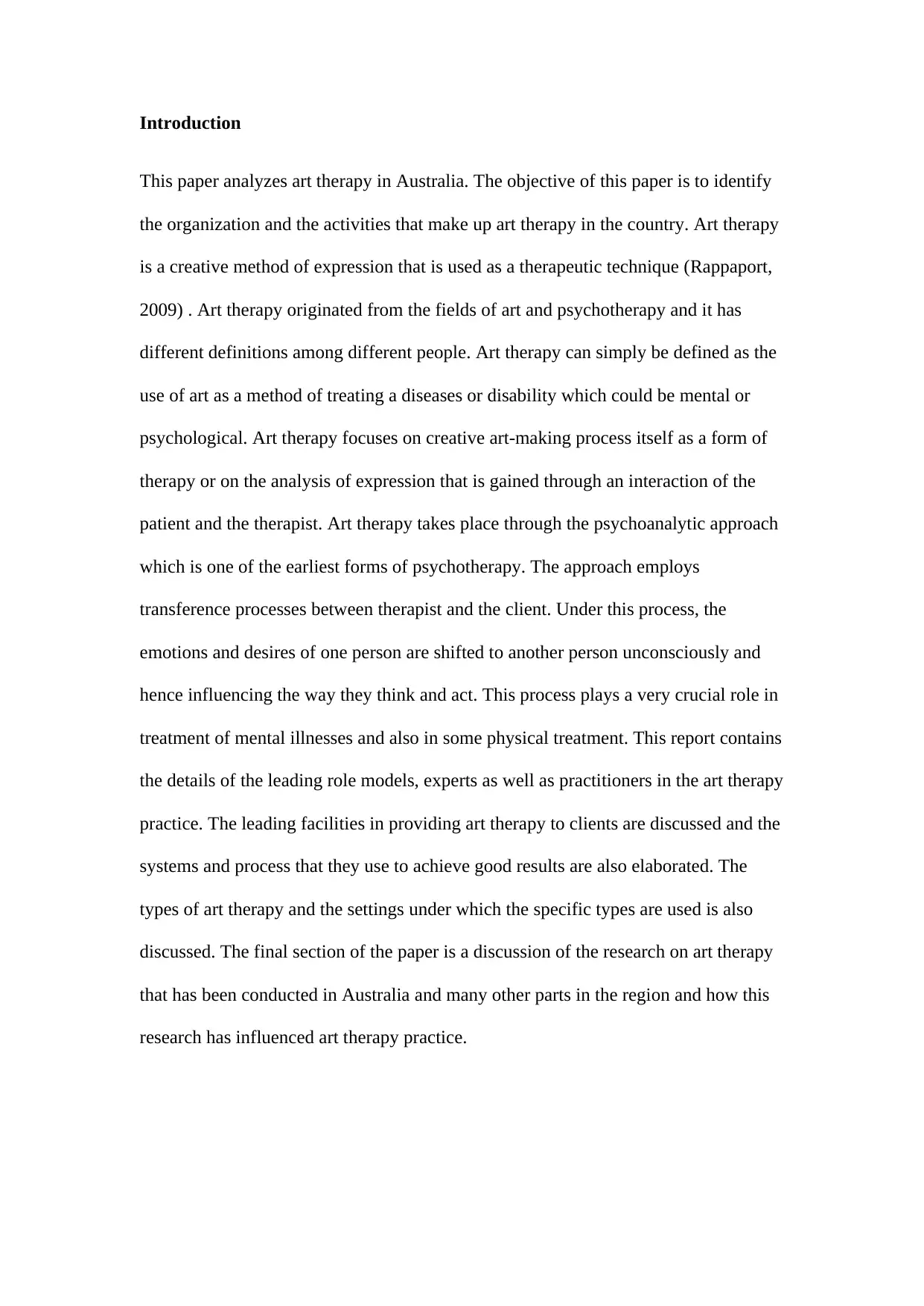
Introduction
This paper analyzes art therapy in Australia. The objective of this paper is to identify
the organization and the activities that make up art therapy in the country. Art therapy
is a creative method of expression that is used as a therapeutic technique (Rappaport,
2009) . Art therapy originated from the fields of art and psychotherapy and it has
different definitions among different people. Art therapy can simply be defined as the
use of art as a method of treating a diseases or disability which could be mental or
psychological. Art therapy focuses on creative art-making process itself as a form of
therapy or on the analysis of expression that is gained through an interaction of the
patient and the therapist. Art therapy takes place through the psychoanalytic approach
which is one of the earliest forms of psychotherapy. The approach employs
transference processes between therapist and the client. Under this process, the
emotions and desires of one person are shifted to another person unconsciously and
hence influencing the way they think and act. This process plays a very crucial role in
treatment of mental illnesses and also in some physical treatment. This report contains
the details of the leading role models, experts as well as practitioners in the art therapy
practice. The leading facilities in providing art therapy to clients are discussed and the
systems and process that they use to achieve good results are also elaborated. The
types of art therapy and the settings under which the specific types are used is also
discussed. The final section of the paper is a discussion of the research on art therapy
that has been conducted in Australia and many other parts in the region and how this
research has influenced art therapy practice.
This paper analyzes art therapy in Australia. The objective of this paper is to identify
the organization and the activities that make up art therapy in the country. Art therapy
is a creative method of expression that is used as a therapeutic technique (Rappaport,
2009) . Art therapy originated from the fields of art and psychotherapy and it has
different definitions among different people. Art therapy can simply be defined as the
use of art as a method of treating a diseases or disability which could be mental or
psychological. Art therapy focuses on creative art-making process itself as a form of
therapy or on the analysis of expression that is gained through an interaction of the
patient and the therapist. Art therapy takes place through the psychoanalytic approach
which is one of the earliest forms of psychotherapy. The approach employs
transference processes between therapist and the client. Under this process, the
emotions and desires of one person are shifted to another person unconsciously and
hence influencing the way they think and act. This process plays a very crucial role in
treatment of mental illnesses and also in some physical treatment. This report contains
the details of the leading role models, experts as well as practitioners in the art therapy
practice. The leading facilities in providing art therapy to clients are discussed and the
systems and process that they use to achieve good results are also elaborated. The
types of art therapy and the settings under which the specific types are used is also
discussed. The final section of the paper is a discussion of the research on art therapy
that has been conducted in Australia and many other parts in the region and how this
research has influenced art therapy practice.
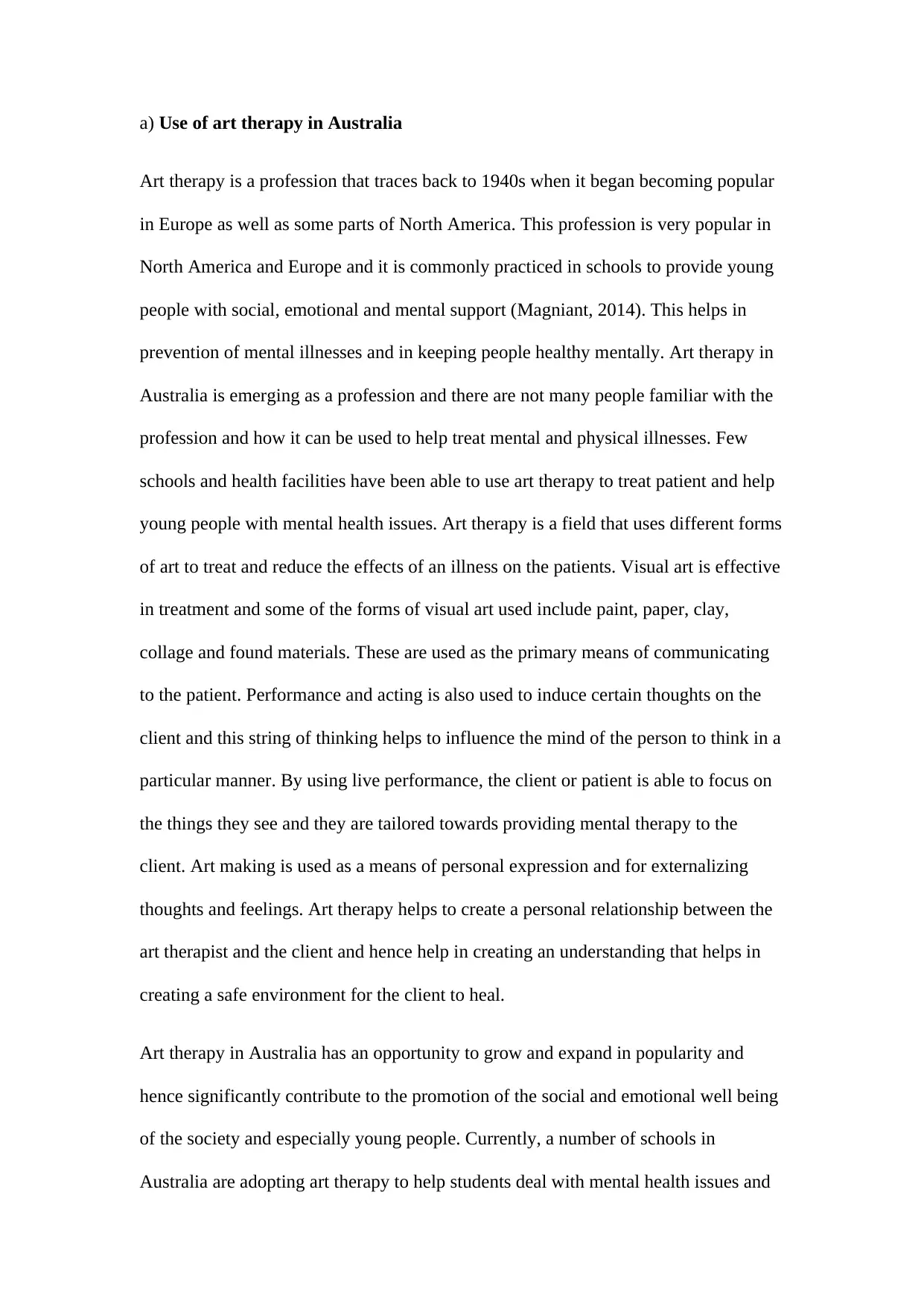
a) Use of art therapy in Australia
Art therapy is a profession that traces back to 1940s when it began becoming popular
in Europe as well as some parts of North America. This profession is very popular in
North America and Europe and it is commonly practiced in schools to provide young
people with social, emotional and mental support (Magniant, 2014). This helps in
prevention of mental illnesses and in keeping people healthy mentally. Art therapy in
Australia is emerging as a profession and there are not many people familiar with the
profession and how it can be used to help treat mental and physical illnesses. Few
schools and health facilities have been able to use art therapy to treat patient and help
young people with mental health issues. Art therapy is a field that uses different forms
of art to treat and reduce the effects of an illness on the patients. Visual art is effective
in treatment and some of the forms of visual art used include paint, paper, clay,
collage and found materials. These are used as the primary means of communicating
to the patient. Performance and acting is also used to induce certain thoughts on the
client and this string of thinking helps to influence the mind of the person to think in a
particular manner. By using live performance, the client or patient is able to focus on
the things they see and they are tailored towards providing mental therapy to the
client. Art making is used as a means of personal expression and for externalizing
thoughts and feelings. Art therapy helps to create a personal relationship between the
art therapist and the client and hence help in creating an understanding that helps in
creating a safe environment for the client to heal.
Art therapy in Australia has an opportunity to grow and expand in popularity and
hence significantly contribute to the promotion of the social and emotional well being
of the society and especially young people. Currently, a number of schools in
Australia are adopting art therapy to help students deal with mental health issues and
Art therapy is a profession that traces back to 1940s when it began becoming popular
in Europe as well as some parts of North America. This profession is very popular in
North America and Europe and it is commonly practiced in schools to provide young
people with social, emotional and mental support (Magniant, 2014). This helps in
prevention of mental illnesses and in keeping people healthy mentally. Art therapy in
Australia is emerging as a profession and there are not many people familiar with the
profession and how it can be used to help treat mental and physical illnesses. Few
schools and health facilities have been able to use art therapy to treat patient and help
young people with mental health issues. Art therapy is a field that uses different forms
of art to treat and reduce the effects of an illness on the patients. Visual art is effective
in treatment and some of the forms of visual art used include paint, paper, clay,
collage and found materials. These are used as the primary means of communicating
to the patient. Performance and acting is also used to induce certain thoughts on the
client and this string of thinking helps to influence the mind of the person to think in a
particular manner. By using live performance, the client or patient is able to focus on
the things they see and they are tailored towards providing mental therapy to the
client. Art making is used as a means of personal expression and for externalizing
thoughts and feelings. Art therapy helps to create a personal relationship between the
art therapist and the client and hence help in creating an understanding that helps in
creating a safe environment for the client to heal.
Art therapy in Australia has an opportunity to grow and expand in popularity and
hence significantly contribute to the promotion of the social and emotional well being
of the society and especially young people. Currently, a number of schools in
Australia are adopting art therapy to help students deal with mental health issues and
⊘ This is a preview!⊘
Do you want full access?
Subscribe today to unlock all pages.

Trusted by 1+ million students worldwide
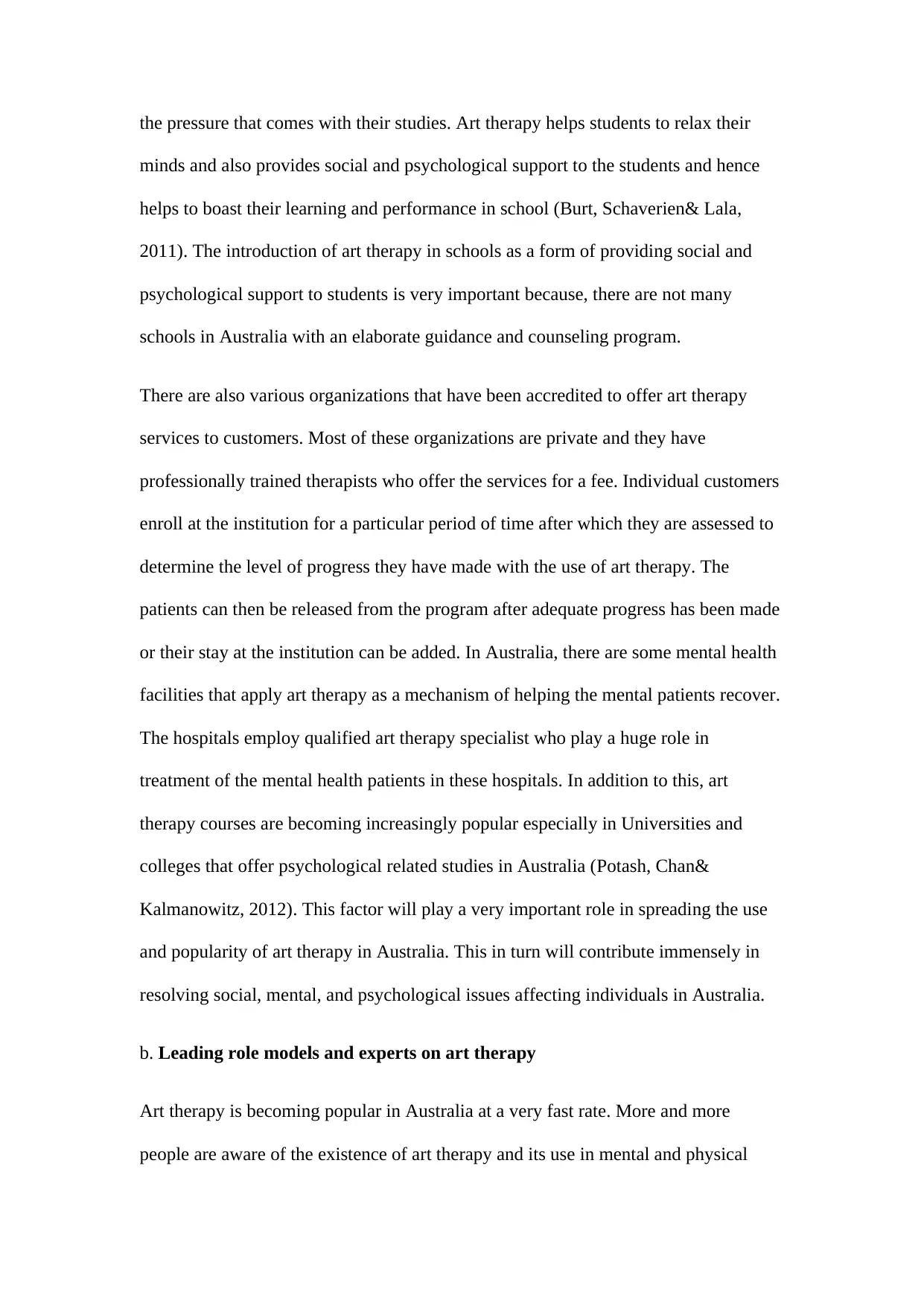
the pressure that comes with their studies. Art therapy helps students to relax their
minds and also provides social and psychological support to the students and hence
helps to boast their learning and performance in school (Burt, Schaverien& Lala,
2011). The introduction of art therapy in schools as a form of providing social and
psychological support to students is very important because, there are not many
schools in Australia with an elaborate guidance and counseling program.
There are also various organizations that have been accredited to offer art therapy
services to customers. Most of these organizations are private and they have
professionally trained therapists who offer the services for a fee. Individual customers
enroll at the institution for a particular period of time after which they are assessed to
determine the level of progress they have made with the use of art therapy. The
patients can then be released from the program after adequate progress has been made
or their stay at the institution can be added. In Australia, there are some mental health
facilities that apply art therapy as a mechanism of helping the mental patients recover.
The hospitals employ qualified art therapy specialist who play a huge role in
treatment of the mental health patients in these hospitals. In addition to this, art
therapy courses are becoming increasingly popular especially in Universities and
colleges that offer psychological related studies in Australia (Potash, Chan&
Kalmanowitz, 2012). This factor will play a very important role in spreading the use
and popularity of art therapy in Australia. This in turn will contribute immensely in
resolving social, mental, and psychological issues affecting individuals in Australia.
b. Leading role models and experts on art therapy
Art therapy is becoming popular in Australia at a very fast rate. More and more
people are aware of the existence of art therapy and its use in mental and physical
minds and also provides social and psychological support to the students and hence
helps to boast their learning and performance in school (Burt, Schaverien& Lala,
2011). The introduction of art therapy in schools as a form of providing social and
psychological support to students is very important because, there are not many
schools in Australia with an elaborate guidance and counseling program.
There are also various organizations that have been accredited to offer art therapy
services to customers. Most of these organizations are private and they have
professionally trained therapists who offer the services for a fee. Individual customers
enroll at the institution for a particular period of time after which they are assessed to
determine the level of progress they have made with the use of art therapy. The
patients can then be released from the program after adequate progress has been made
or their stay at the institution can be added. In Australia, there are some mental health
facilities that apply art therapy as a mechanism of helping the mental patients recover.
The hospitals employ qualified art therapy specialist who play a huge role in
treatment of the mental health patients in these hospitals. In addition to this, art
therapy courses are becoming increasingly popular especially in Universities and
colleges that offer psychological related studies in Australia (Potash, Chan&
Kalmanowitz, 2012). This factor will play a very important role in spreading the use
and popularity of art therapy in Australia. This in turn will contribute immensely in
resolving social, mental, and psychological issues affecting individuals in Australia.
b. Leading role models and experts on art therapy
Art therapy is becoming popular in Australia at a very fast rate. More and more
people are aware of the existence of art therapy and its use in mental and physical
Paraphrase This Document
Need a fresh take? Get an instant paraphrase of this document with our AI Paraphraser
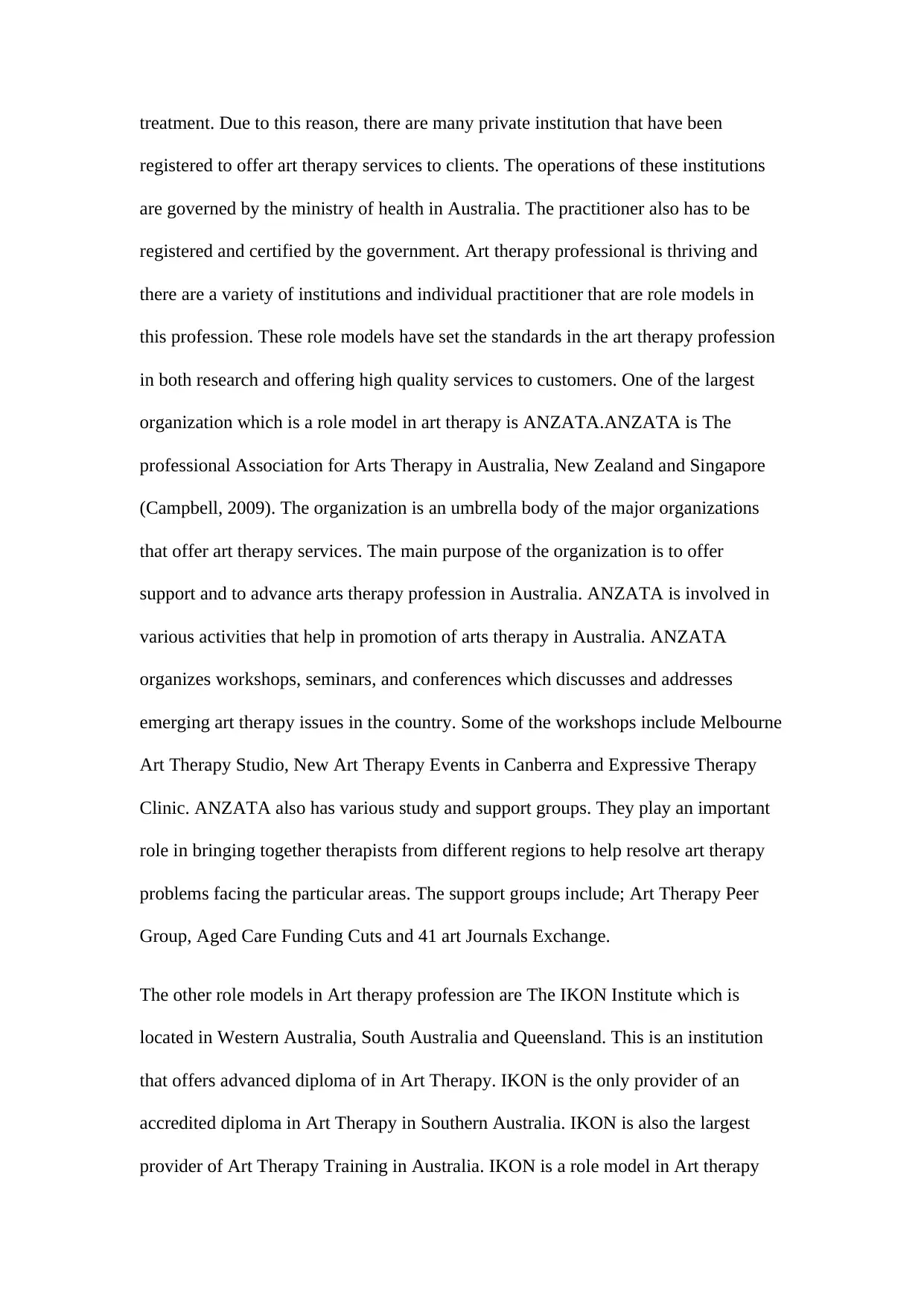
treatment. Due to this reason, there are many private institution that have been
registered to offer art therapy services to clients. The operations of these institutions
are governed by the ministry of health in Australia. The practitioner also has to be
registered and certified by the government. Art therapy professional is thriving and
there are a variety of institutions and individual practitioner that are role models in
this profession. These role models have set the standards in the art therapy profession
in both research and offering high quality services to customers. One of the largest
organization which is a role model in art therapy is ANZATA.ANZATA is The
professional Association for Arts Therapy in Australia, New Zealand and Singapore
(Campbell, 2009). The organization is an umbrella body of the major organizations
that offer art therapy services. The main purpose of the organization is to offer
support and to advance arts therapy profession in Australia. ANZATA is involved in
various activities that help in promotion of arts therapy in Australia. ANZATA
organizes workshops, seminars, and conferences which discusses and addresses
emerging art therapy issues in the country. Some of the workshops include Melbourne
Art Therapy Studio, New Art Therapy Events in Canberra and Expressive Therapy
Clinic. ANZATA also has various study and support groups. They play an important
role in bringing together therapists from different regions to help resolve art therapy
problems facing the particular areas. The support groups include; Art Therapy Peer
Group, Aged Care Funding Cuts and 41 art Journals Exchange.
The other role models in Art therapy profession are The IKON Institute which is
located in Western Australia, South Australia and Queensland. This is an institution
that offers advanced diploma of in Art Therapy. IKON is the only provider of an
accredited diploma in Art Therapy in Southern Australia. IKON is also the largest
provider of Art Therapy Training in Australia. IKON is a role model in Art therapy
registered to offer art therapy services to clients. The operations of these institutions
are governed by the ministry of health in Australia. The practitioner also has to be
registered and certified by the government. Art therapy professional is thriving and
there are a variety of institutions and individual practitioner that are role models in
this profession. These role models have set the standards in the art therapy profession
in both research and offering high quality services to customers. One of the largest
organization which is a role model in art therapy is ANZATA.ANZATA is The
professional Association for Arts Therapy in Australia, New Zealand and Singapore
(Campbell, 2009). The organization is an umbrella body of the major organizations
that offer art therapy services. The main purpose of the organization is to offer
support and to advance arts therapy profession in Australia. ANZATA is involved in
various activities that help in promotion of arts therapy in Australia. ANZATA
organizes workshops, seminars, and conferences which discusses and addresses
emerging art therapy issues in the country. Some of the workshops include Melbourne
Art Therapy Studio, New Art Therapy Events in Canberra and Expressive Therapy
Clinic. ANZATA also has various study and support groups. They play an important
role in bringing together therapists from different regions to help resolve art therapy
problems facing the particular areas. The support groups include; Art Therapy Peer
Group, Aged Care Funding Cuts and 41 art Journals Exchange.
The other role models in Art therapy profession are The IKON Institute which is
located in Western Australia, South Australia and Queensland. This is an institution
that offers advanced diploma of in Art Therapy. IKON is the only provider of an
accredited diploma in Art Therapy in Southern Australia. IKON is also the largest
provider of Art Therapy Training in Australia. IKON is a role model in Art therapy
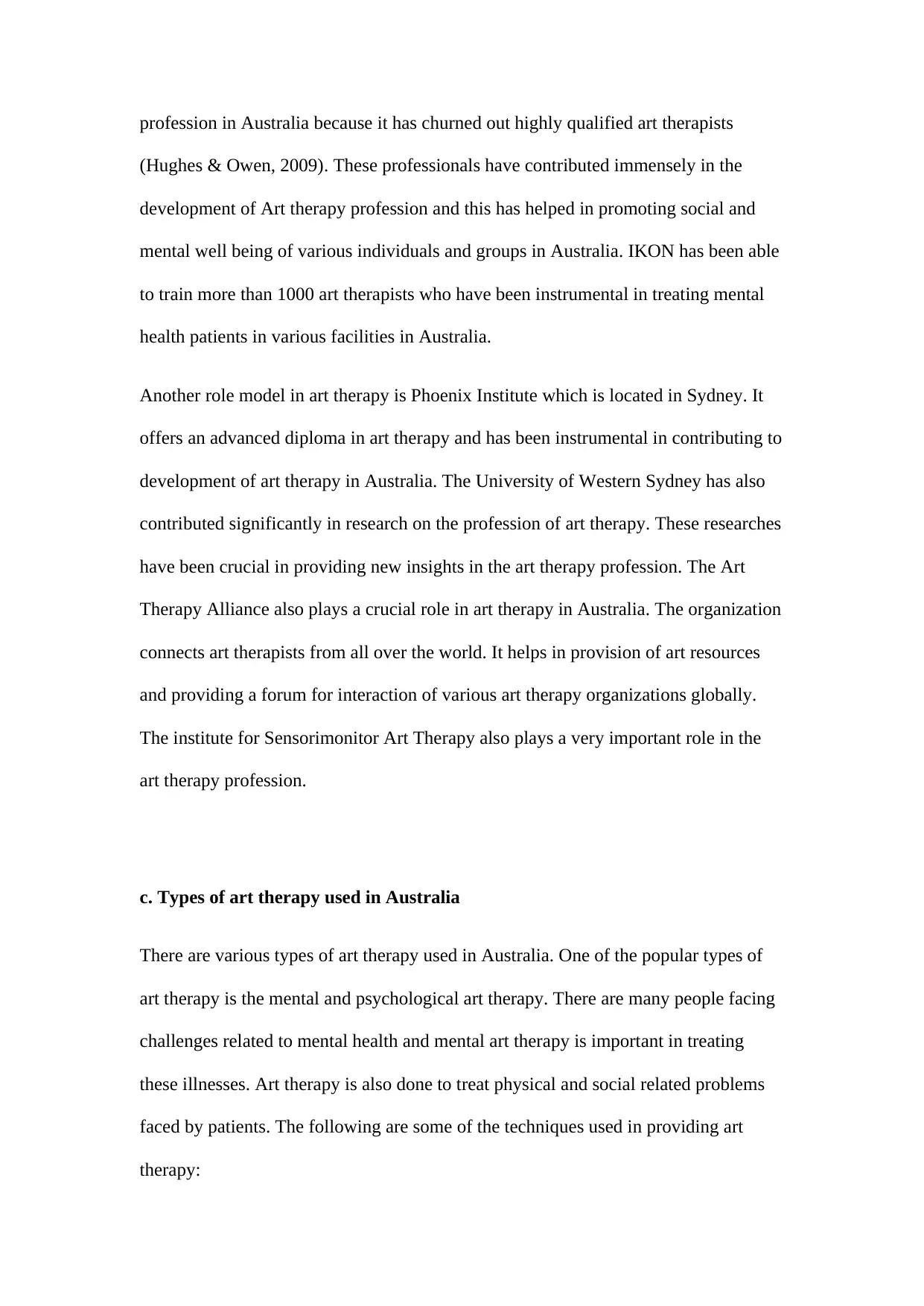
profession in Australia because it has churned out highly qualified art therapists
(Hughes & Owen, 2009). These professionals have contributed immensely in the
development of Art therapy profession and this has helped in promoting social and
mental well being of various individuals and groups in Australia. IKON has been able
to train more than 1000 art therapists who have been instrumental in treating mental
health patients in various facilities in Australia.
Another role model in art therapy is Phoenix Institute which is located in Sydney. It
offers an advanced diploma in art therapy and has been instrumental in contributing to
development of art therapy in Australia. The University of Western Sydney has also
contributed significantly in research on the profession of art therapy. These researches
have been crucial in providing new insights in the art therapy profession. The Art
Therapy Alliance also plays a crucial role in art therapy in Australia. The organization
connects art therapists from all over the world. It helps in provision of art resources
and providing a forum for interaction of various art therapy organizations globally.
The institute for Sensorimonitor Art Therapy also plays a very important role in the
art therapy profession.
c. Types of art therapy used in Australia
There are various types of art therapy used in Australia. One of the popular types of
art therapy is the mental and psychological art therapy. There are many people facing
challenges related to mental health and mental art therapy is important in treating
these illnesses. Art therapy is also done to treat physical and social related problems
faced by patients. The following are some of the techniques used in providing art
therapy:
(Hughes & Owen, 2009). These professionals have contributed immensely in the
development of Art therapy profession and this has helped in promoting social and
mental well being of various individuals and groups in Australia. IKON has been able
to train more than 1000 art therapists who have been instrumental in treating mental
health patients in various facilities in Australia.
Another role model in art therapy is Phoenix Institute which is located in Sydney. It
offers an advanced diploma in art therapy and has been instrumental in contributing to
development of art therapy in Australia. The University of Western Sydney has also
contributed significantly in research on the profession of art therapy. These researches
have been crucial in providing new insights in the art therapy profession. The Art
Therapy Alliance also plays a crucial role in art therapy in Australia. The organization
connects art therapists from all over the world. It helps in provision of art resources
and providing a forum for interaction of various art therapy organizations globally.
The institute for Sensorimonitor Art Therapy also plays a very important role in the
art therapy profession.
c. Types of art therapy used in Australia
There are various types of art therapy used in Australia. One of the popular types of
art therapy is the mental and psychological art therapy. There are many people facing
challenges related to mental health and mental art therapy is important in treating
these illnesses. Art therapy is also done to treat physical and social related problems
faced by patients. The following are some of the techniques used in providing art
therapy:
⊘ This is a preview!⊘
Do you want full access?
Subscribe today to unlock all pages.

Trusted by 1+ million students worldwide
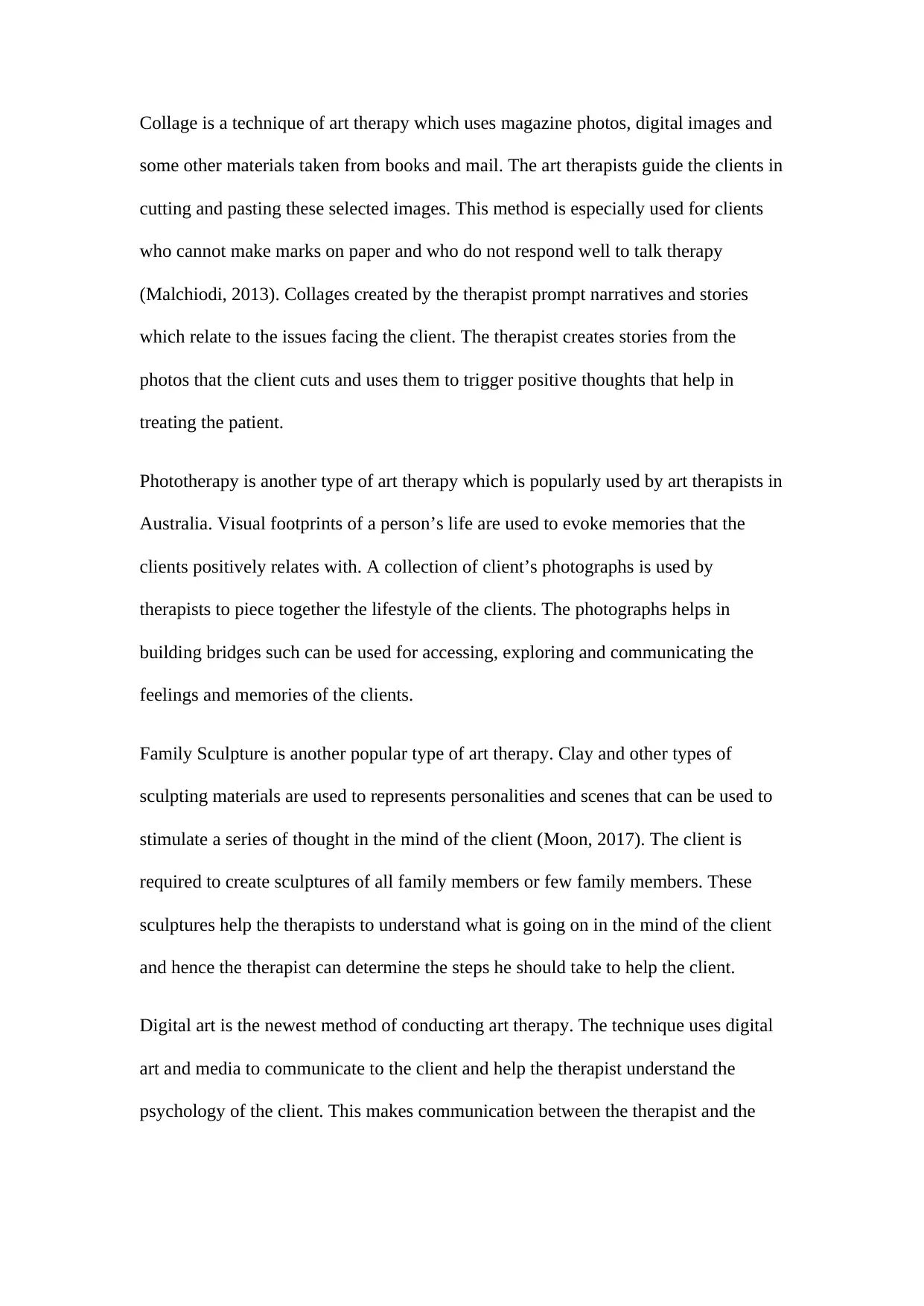
Collage is a technique of art therapy which uses magazine photos, digital images and
some other materials taken from books and mail. The art therapists guide the clients in
cutting and pasting these selected images. This method is especially used for clients
who cannot make marks on paper and who do not respond well to talk therapy
(Malchiodi, 2013). Collages created by the therapist prompt narratives and stories
which relate to the issues facing the client. The therapist creates stories from the
photos that the client cuts and uses them to trigger positive thoughts that help in
treating the patient.
Phototherapy is another type of art therapy which is popularly used by art therapists in
Australia. Visual footprints of a person’s life are used to evoke memories that the
clients positively relates with. A collection of client’s photographs is used by
therapists to piece together the lifestyle of the clients. The photographs helps in
building bridges such can be used for accessing, exploring and communicating the
feelings and memories of the clients.
Family Sculpture is another popular type of art therapy. Clay and other types of
sculpting materials are used to represents personalities and scenes that can be used to
stimulate a series of thought in the mind of the client (Moon, 2017). The client is
required to create sculptures of all family members or few family members. These
sculptures help the therapists to understand what is going on in the mind of the client
and hence the therapist can determine the steps he should take to help the client.
Digital art is the newest method of conducting art therapy. The technique uses digital
art and media to communicate to the client and help the therapist understand the
psychology of the client. This makes communication between the therapist and the
some other materials taken from books and mail. The art therapists guide the clients in
cutting and pasting these selected images. This method is especially used for clients
who cannot make marks on paper and who do not respond well to talk therapy
(Malchiodi, 2013). Collages created by the therapist prompt narratives and stories
which relate to the issues facing the client. The therapist creates stories from the
photos that the client cuts and uses them to trigger positive thoughts that help in
treating the patient.
Phototherapy is another type of art therapy which is popularly used by art therapists in
Australia. Visual footprints of a person’s life are used to evoke memories that the
clients positively relates with. A collection of client’s photographs is used by
therapists to piece together the lifestyle of the clients. The photographs helps in
building bridges such can be used for accessing, exploring and communicating the
feelings and memories of the clients.
Family Sculpture is another popular type of art therapy. Clay and other types of
sculpting materials are used to represents personalities and scenes that can be used to
stimulate a series of thought in the mind of the client (Moon, 2017). The client is
required to create sculptures of all family members or few family members. These
sculptures help the therapists to understand what is going on in the mind of the client
and hence the therapist can determine the steps he should take to help the client.
Digital art is the newest method of conducting art therapy. The technique uses digital
art and media to communicate to the client and help the therapist understand the
psychology of the client. This makes communication between the therapist and the
Paraphrase This Document
Need a fresh take? Get an instant paraphrase of this document with our AI Paraphraser
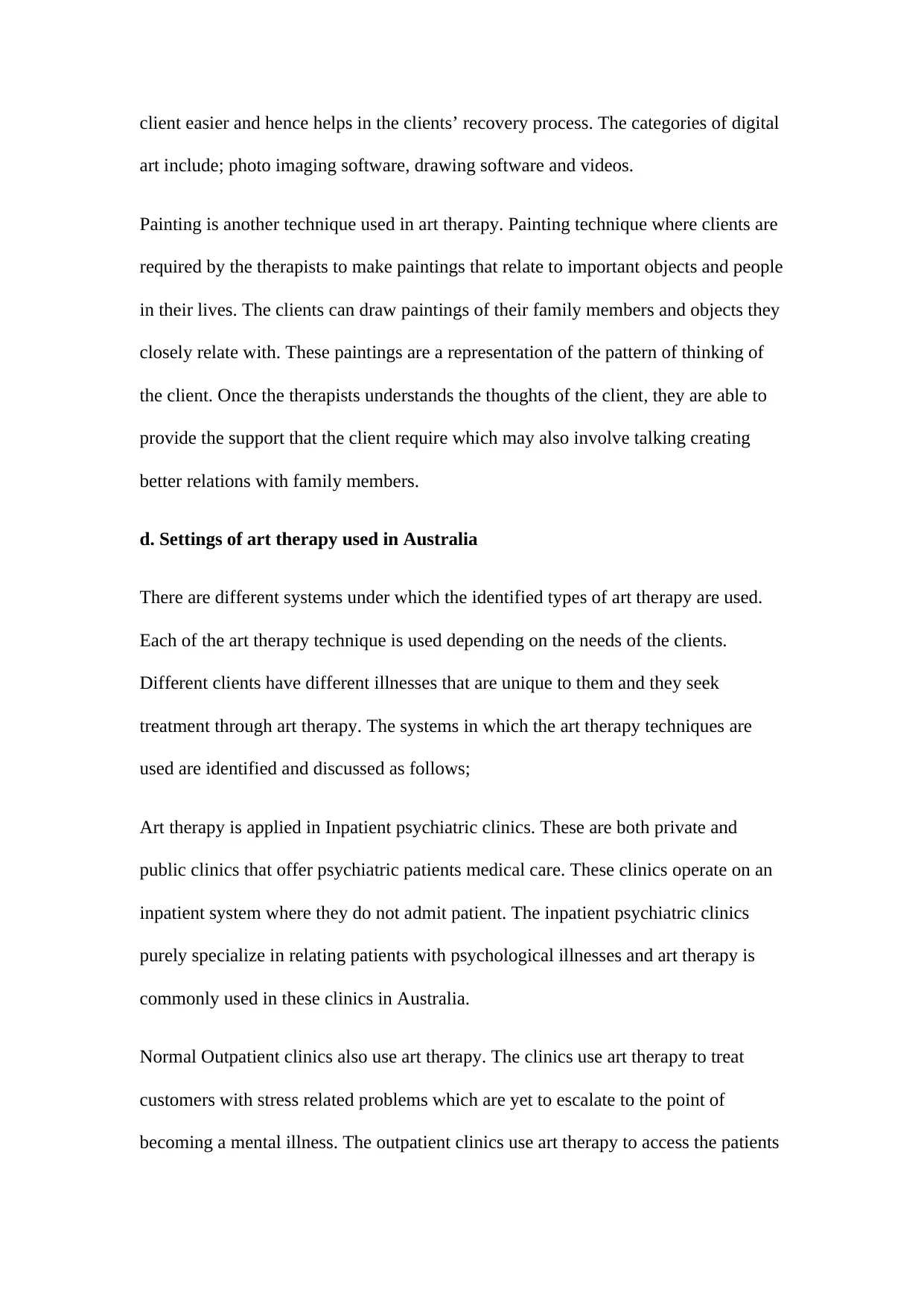
client easier and hence helps in the clients’ recovery process. The categories of digital
art include; photo imaging software, drawing software and videos.
Painting is another technique used in art therapy. Painting technique where clients are
required by the therapists to make paintings that relate to important objects and people
in their lives. The clients can draw paintings of their family members and objects they
closely relate with. These paintings are a representation of the pattern of thinking of
the client. Once the therapists understands the thoughts of the client, they are able to
provide the support that the client require which may also involve talking creating
better relations with family members.
d. Settings of art therapy used in Australia
There are different systems under which the identified types of art therapy are used.
Each of the art therapy technique is used depending on the needs of the clients.
Different clients have different illnesses that are unique to them and they seek
treatment through art therapy. The systems in which the art therapy techniques are
used are identified and discussed as follows;
Art therapy is applied in Inpatient psychiatric clinics. These are both private and
public clinics that offer psychiatric patients medical care. These clinics operate on an
inpatient system where they do not admit patient. The inpatient psychiatric clinics
purely specialize in relating patients with psychological illnesses and art therapy is
commonly used in these clinics in Australia.
Normal Outpatient clinics also use art therapy. The clinics use art therapy to treat
customers with stress related problems which are yet to escalate to the point of
becoming a mental illness. The outpatient clinics use art therapy to access the patients
art include; photo imaging software, drawing software and videos.
Painting is another technique used in art therapy. Painting technique where clients are
required by the therapists to make paintings that relate to important objects and people
in their lives. The clients can draw paintings of their family members and objects they
closely relate with. These paintings are a representation of the pattern of thinking of
the client. Once the therapists understands the thoughts of the client, they are able to
provide the support that the client require which may also involve talking creating
better relations with family members.
d. Settings of art therapy used in Australia
There are different systems under which the identified types of art therapy are used.
Each of the art therapy technique is used depending on the needs of the clients.
Different clients have different illnesses that are unique to them and they seek
treatment through art therapy. The systems in which the art therapy techniques are
used are identified and discussed as follows;
Art therapy is applied in Inpatient psychiatric clinics. These are both private and
public clinics that offer psychiatric patients medical care. These clinics operate on an
inpatient system where they do not admit patient. The inpatient psychiatric clinics
purely specialize in relating patients with psychological illnesses and art therapy is
commonly used in these clinics in Australia.
Normal Outpatient clinics also use art therapy. The clinics use art therapy to treat
customers with stress related problems which are yet to escalate to the point of
becoming a mental illness. The outpatient clinics use art therapy to access the patients
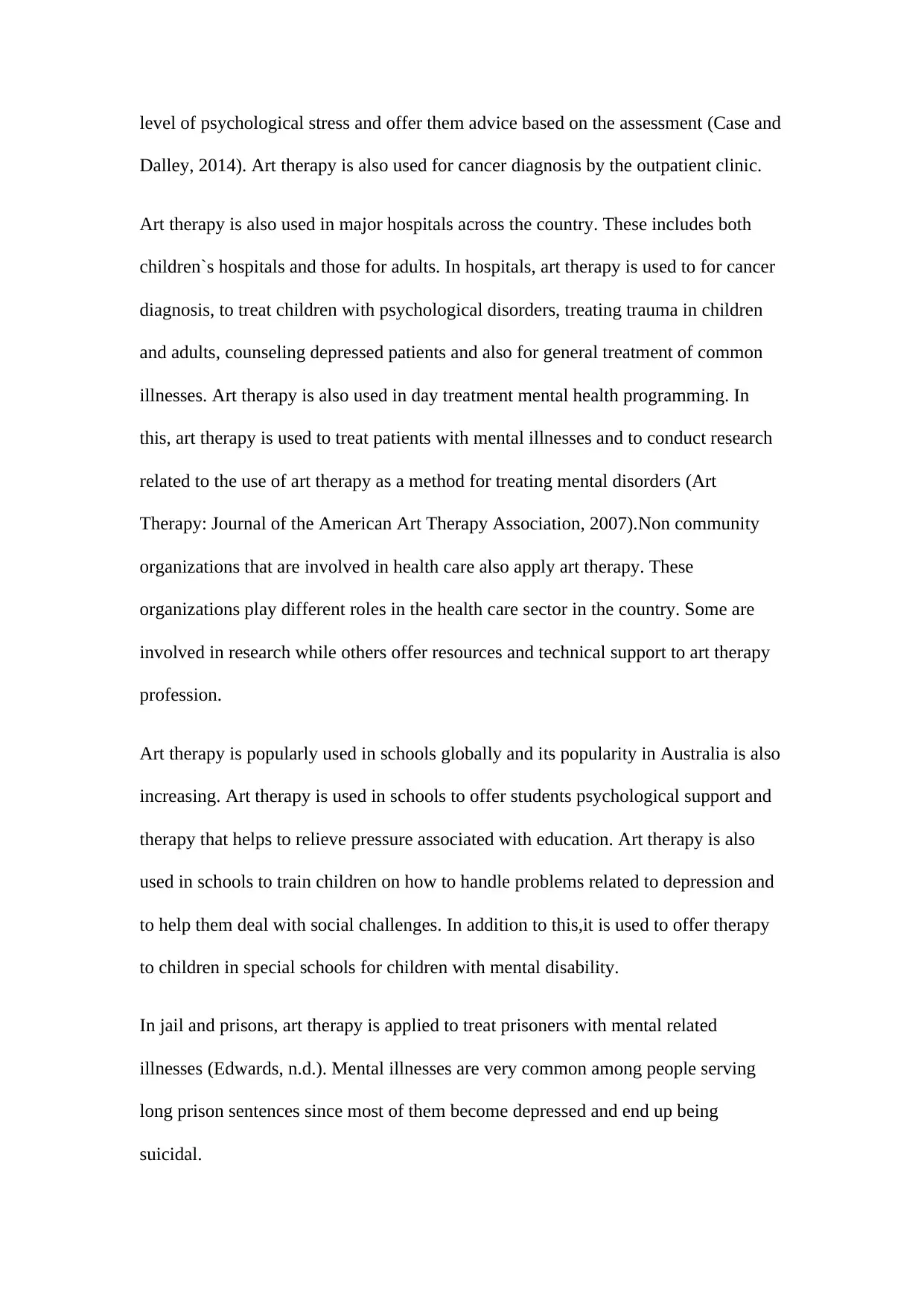
level of psychological stress and offer them advice based on the assessment (Case and
Dalley, 2014). Art therapy is also used for cancer diagnosis by the outpatient clinic.
Art therapy is also used in major hospitals across the country. These includes both
children`s hospitals and those for adults. In hospitals, art therapy is used to for cancer
diagnosis, to treat children with psychological disorders, treating trauma in children
and adults, counseling depressed patients and also for general treatment of common
illnesses. Art therapy is also used in day treatment mental health programming. In
this, art therapy is used to treat patients with mental illnesses and to conduct research
related to the use of art therapy as a method for treating mental disorders (Art
Therapy: Journal of the American Art Therapy Association, 2007).Non community
organizations that are involved in health care also apply art therapy. These
organizations play different roles in the health care sector in the country. Some are
involved in research while others offer resources and technical support to art therapy
profession.
Art therapy is popularly used in schools globally and its popularity in Australia is also
increasing. Art therapy is used in schools to offer students psychological support and
therapy that helps to relieve pressure associated with education. Art therapy is also
used in schools to train children on how to handle problems related to depression and
to help them deal with social challenges. In addition to this,it is used to offer therapy
to children in special schools for children with mental disability.
In jail and prisons, art therapy is applied to treat prisoners with mental related
illnesses (Edwards, n.d.). Mental illnesses are very common among people serving
long prison sentences since most of them become depressed and end up being
suicidal.
Dalley, 2014). Art therapy is also used for cancer diagnosis by the outpatient clinic.
Art therapy is also used in major hospitals across the country. These includes both
children`s hospitals and those for adults. In hospitals, art therapy is used to for cancer
diagnosis, to treat children with psychological disorders, treating trauma in children
and adults, counseling depressed patients and also for general treatment of common
illnesses. Art therapy is also used in day treatment mental health programming. In
this, art therapy is used to treat patients with mental illnesses and to conduct research
related to the use of art therapy as a method for treating mental disorders (Art
Therapy: Journal of the American Art Therapy Association, 2007).Non community
organizations that are involved in health care also apply art therapy. These
organizations play different roles in the health care sector in the country. Some are
involved in research while others offer resources and technical support to art therapy
profession.
Art therapy is popularly used in schools globally and its popularity in Australia is also
increasing. Art therapy is used in schools to offer students psychological support and
therapy that helps to relieve pressure associated with education. Art therapy is also
used in schools to train children on how to handle problems related to depression and
to help them deal with social challenges. In addition to this,it is used to offer therapy
to children in special schools for children with mental disability.
In jail and prisons, art therapy is applied to treat prisoners with mental related
illnesses (Edwards, n.d.). Mental illnesses are very common among people serving
long prison sentences since most of them become depressed and end up being
suicidal.
⊘ This is a preview!⊘
Do you want full access?
Subscribe today to unlock all pages.

Trusted by 1+ million students worldwide
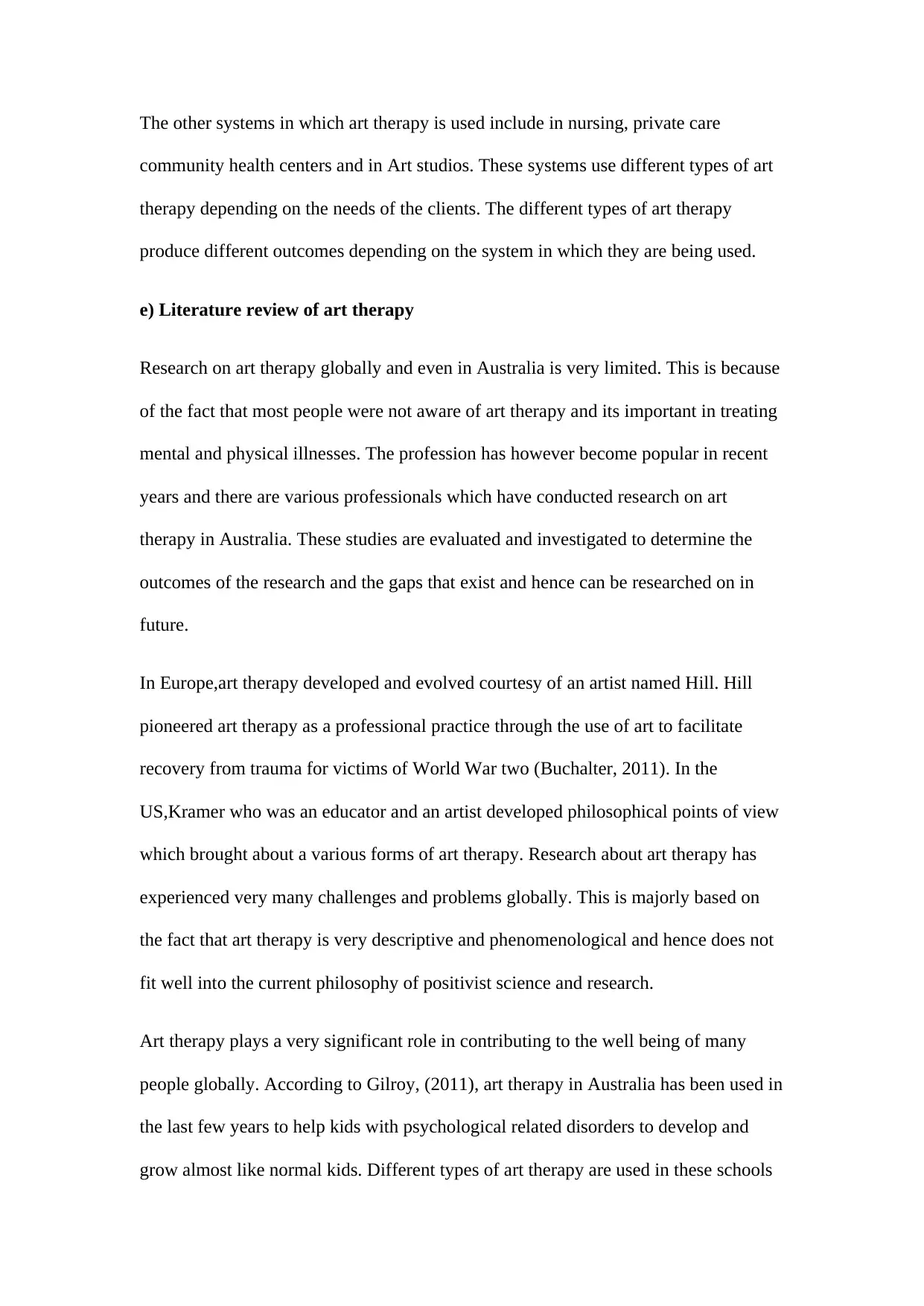
The other systems in which art therapy is used include in nursing, private care
community health centers and in Art studios. These systems use different types of art
therapy depending on the needs of the clients. The different types of art therapy
produce different outcomes depending on the system in which they are being used.
e) Literature review of art therapy
Research on art therapy globally and even in Australia is very limited. This is because
of the fact that most people were not aware of art therapy and its important in treating
mental and physical illnesses. The profession has however become popular in recent
years and there are various professionals which have conducted research on art
therapy in Australia. These studies are evaluated and investigated to determine the
outcomes of the research and the gaps that exist and hence can be researched on in
future.
In Europe,art therapy developed and evolved courtesy of an artist named Hill. Hill
pioneered art therapy as a professional practice through the use of art to facilitate
recovery from trauma for victims of World War two (Buchalter, 2011). In the
US,Kramer who was an educator and an artist developed philosophical points of view
which brought about a various forms of art therapy. Research about art therapy has
experienced very many challenges and problems globally. This is majorly based on
the fact that art therapy is very descriptive and phenomenological and hence does not
fit well into the current philosophy of positivist science and research.
Art therapy plays a very significant role in contributing to the well being of many
people globally. According to Gilroy, (2011), art therapy in Australia has been used in
the last few years to help kids with psychological related disorders to develop and
grow almost like normal kids. Different types of art therapy are used in these schools
community health centers and in Art studios. These systems use different types of art
therapy depending on the needs of the clients. The different types of art therapy
produce different outcomes depending on the system in which they are being used.
e) Literature review of art therapy
Research on art therapy globally and even in Australia is very limited. This is because
of the fact that most people were not aware of art therapy and its important in treating
mental and physical illnesses. The profession has however become popular in recent
years and there are various professionals which have conducted research on art
therapy in Australia. These studies are evaluated and investigated to determine the
outcomes of the research and the gaps that exist and hence can be researched on in
future.
In Europe,art therapy developed and evolved courtesy of an artist named Hill. Hill
pioneered art therapy as a professional practice through the use of art to facilitate
recovery from trauma for victims of World War two (Buchalter, 2011). In the
US,Kramer who was an educator and an artist developed philosophical points of view
which brought about a various forms of art therapy. Research about art therapy has
experienced very many challenges and problems globally. This is majorly based on
the fact that art therapy is very descriptive and phenomenological and hence does not
fit well into the current philosophy of positivist science and research.
Art therapy plays a very significant role in contributing to the well being of many
people globally. According to Gilroy, (2011), art therapy in Australia has been used in
the last few years to help kids with psychological related disorders to develop and
grow almost like normal kids. Different types of art therapy are used in these schools
Paraphrase This Document
Need a fresh take? Get an instant paraphrase of this document with our AI Paraphraser
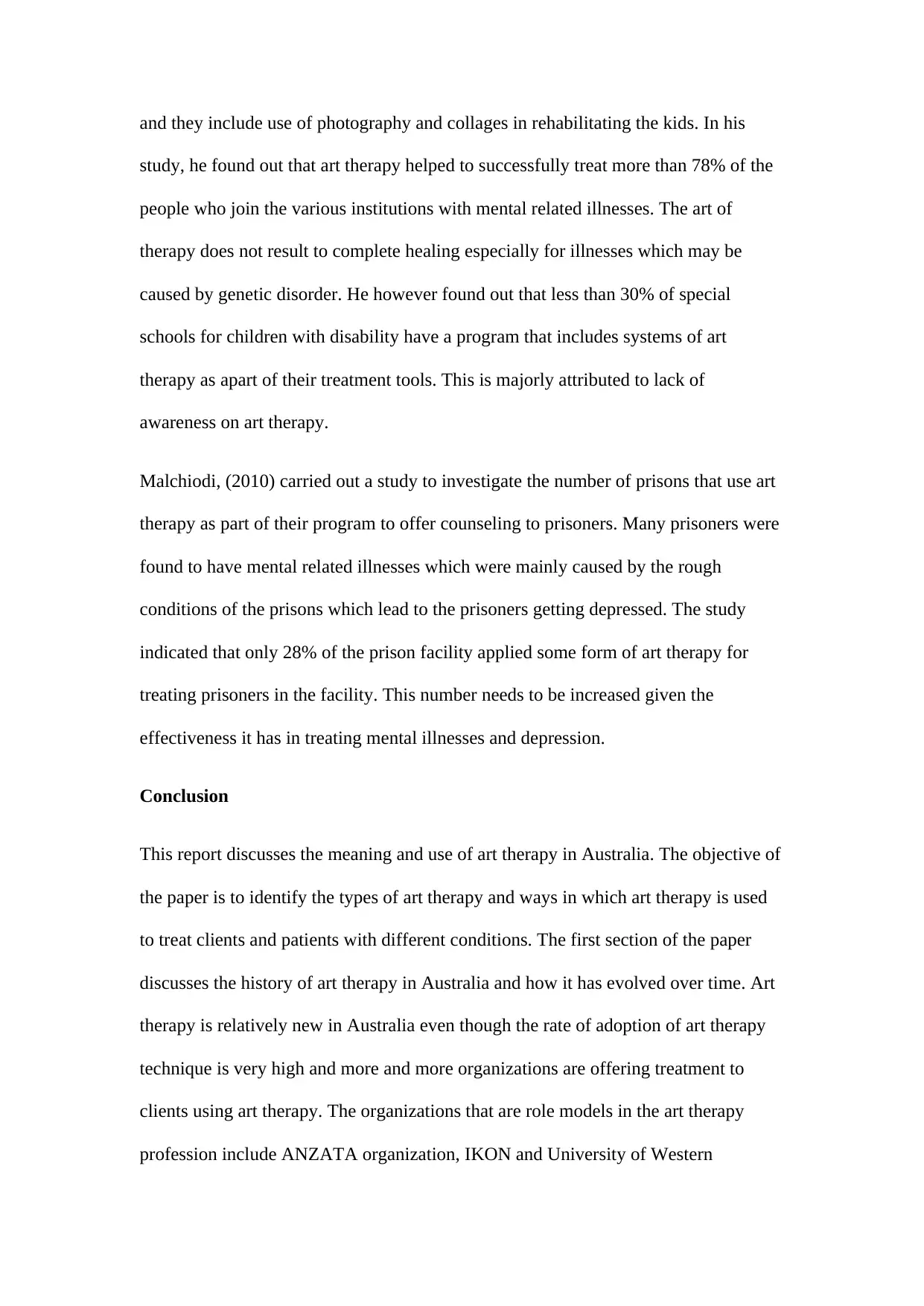
and they include use of photography and collages in rehabilitating the kids. In his
study, he found out that art therapy helped to successfully treat more than 78% of the
people who join the various institutions with mental related illnesses. The art of
therapy does not result to complete healing especially for illnesses which may be
caused by genetic disorder. He however found out that less than 30% of special
schools for children with disability have a program that includes systems of art
therapy as apart of their treatment tools. This is majorly attributed to lack of
awareness on art therapy.
Malchiodi, (2010) carried out a study to investigate the number of prisons that use art
therapy as part of their program to offer counseling to prisoners. Many prisoners were
found to have mental related illnesses which were mainly caused by the rough
conditions of the prisons which lead to the prisoners getting depressed. The study
indicated that only 28% of the prison facility applied some form of art therapy for
treating prisoners in the facility. This number needs to be increased given the
effectiveness it has in treating mental illnesses and depression.
Conclusion
This report discusses the meaning and use of art therapy in Australia. The objective of
the paper is to identify the types of art therapy and ways in which art therapy is used
to treat clients and patients with different conditions. The first section of the paper
discusses the history of art therapy in Australia and how it has evolved over time. Art
therapy is relatively new in Australia even though the rate of adoption of art therapy
technique is very high and more and more organizations are offering treatment to
clients using art therapy. The organizations that are role models in the art therapy
profession include ANZATA organization, IKON and University of Western
study, he found out that art therapy helped to successfully treat more than 78% of the
people who join the various institutions with mental related illnesses. The art of
therapy does not result to complete healing especially for illnesses which may be
caused by genetic disorder. He however found out that less than 30% of special
schools for children with disability have a program that includes systems of art
therapy as apart of their treatment tools. This is majorly attributed to lack of
awareness on art therapy.
Malchiodi, (2010) carried out a study to investigate the number of prisons that use art
therapy as part of their program to offer counseling to prisoners. Many prisoners were
found to have mental related illnesses which were mainly caused by the rough
conditions of the prisons which lead to the prisoners getting depressed. The study
indicated that only 28% of the prison facility applied some form of art therapy for
treating prisoners in the facility. This number needs to be increased given the
effectiveness it has in treating mental illnesses and depression.
Conclusion
This report discusses the meaning and use of art therapy in Australia. The objective of
the paper is to identify the types of art therapy and ways in which art therapy is used
to treat clients and patients with different conditions. The first section of the paper
discusses the history of art therapy in Australia and how it has evolved over time. Art
therapy is relatively new in Australia even though the rate of adoption of art therapy
technique is very high and more and more organizations are offering treatment to
clients using art therapy. The organizations that are role models in the art therapy
profession include ANZATA organization, IKON and University of Western
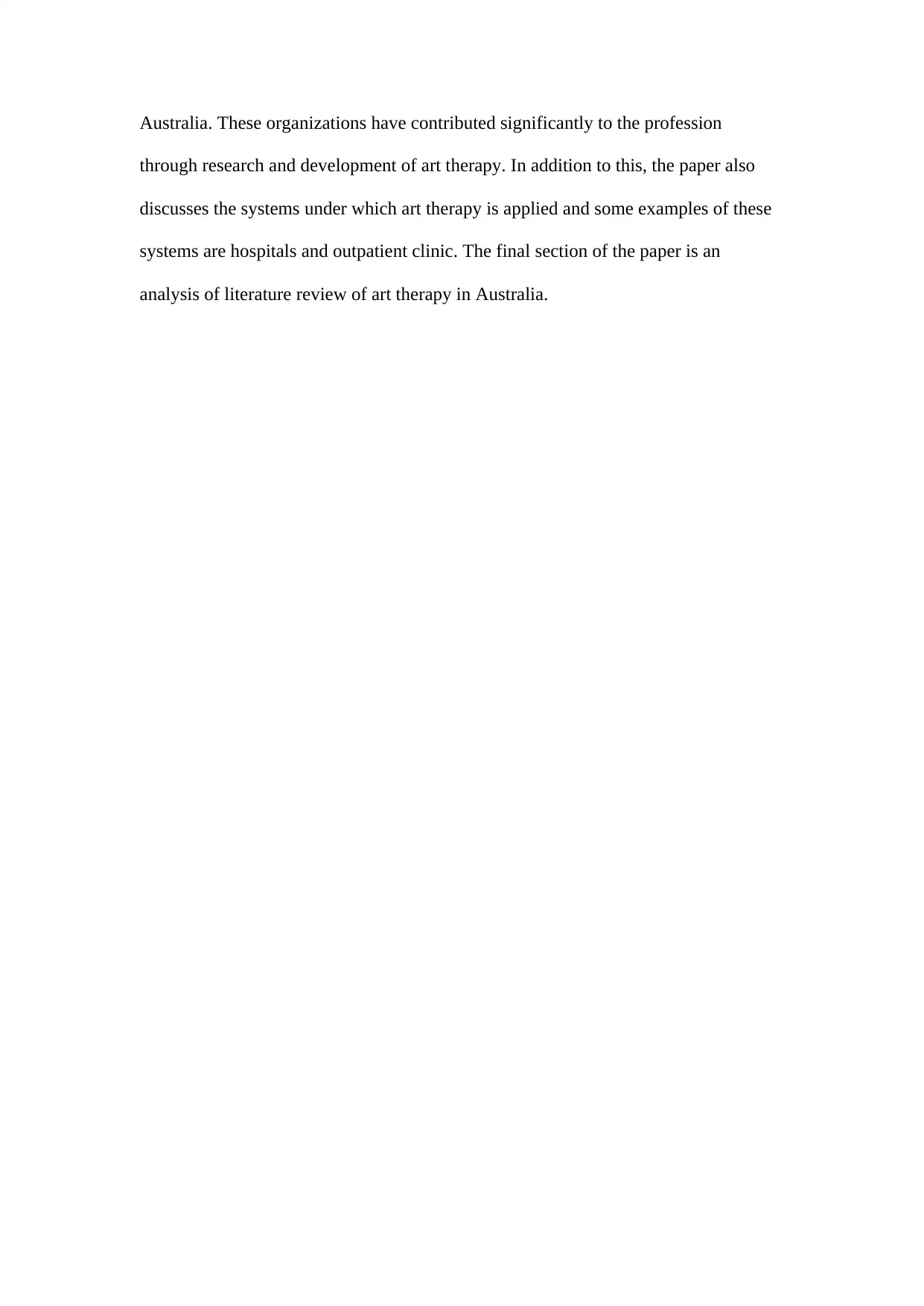
Australia. These organizations have contributed significantly to the profession
through research and development of art therapy. In addition to this, the paper also
discusses the systems under which art therapy is applied and some examples of these
systems are hospitals and outpatient clinic. The final section of the paper is an
analysis of literature review of art therapy in Australia.
through research and development of art therapy. In addition to this, the paper also
discusses the systems under which art therapy is applied and some examples of these
systems are hospitals and outpatient clinic. The final section of the paper is an
analysis of literature review of art therapy in Australia.
⊘ This is a preview!⊘
Do you want full access?
Subscribe today to unlock all pages.

Trusted by 1+ million students worldwide
1 out of 14
Related Documents
Your All-in-One AI-Powered Toolkit for Academic Success.
+13062052269
info@desklib.com
Available 24*7 on WhatsApp / Email
![[object Object]](/_next/static/media/star-bottom.7253800d.svg)
Unlock your academic potential
Copyright © 2020–2025 A2Z Services. All Rights Reserved. Developed and managed by ZUCOL.





